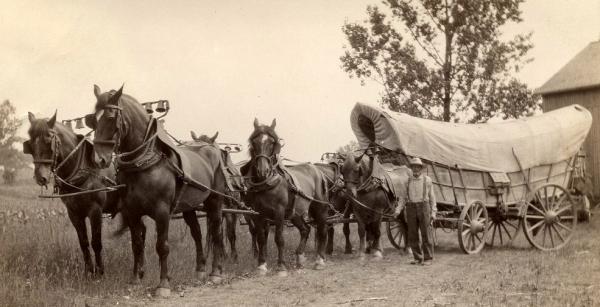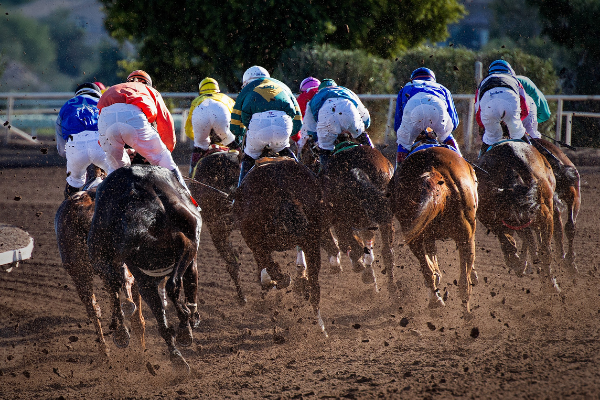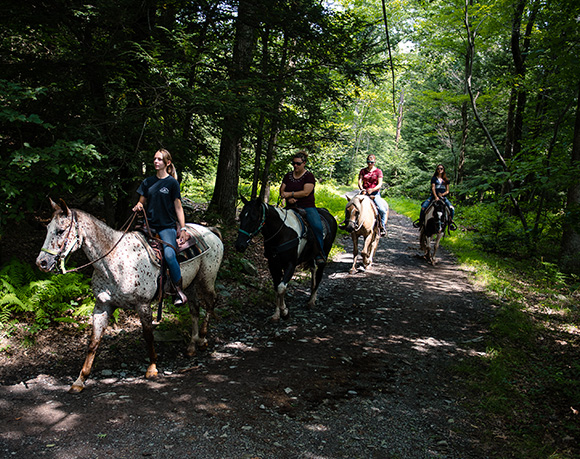30 Jul The History of Horses in the Greater Philadelphia Area
Horse History, Summed Up
Contrary to common knowledge, horses originated millennia ago in what is now North America. These horses are suspected to have migrated to Europe via the Bearing Land Bridge. They roamed throughout North America until about 8,000 – 10,000 years ago, when they went extinct from unknown causes. It was not until 1493 that Iberian horses arrived back in North America with the Spanish fleet. Some of these horses escaped and became feral (leading to repopulation in the Midwest) and eventually some of them were traded by the Spanish to the Native Americans, where they became a mode of transport for the Native Americans of the Midwest.
This reintroduction led to the normalization of horses though, since they are expensive to maintain and require a great deal of land, they were often relegated to the elites of the day. Further settlement by Europeans brought additional breeds that were, again, used by the wealthy to pull carriages and were ridden for sport. As the burgeoning U.S. expanded and the cities of the east coast became better connected with roads, trade increased. Oxen, the typical prime-mover for heavy loads due to their sturdy constitution, were reliable but slow paced. This clashed with the increased trade demands and wealthy merchants began to use horses to transport their products at a faster rate. This led to the gradual replacement of oxen with horses.
Horses were much more prevalent in the Southern U.S. as escaped wild horses spread north from the Spanish who settled what is now Mexico. Eventually they were captured, tamed, and bred by Native Americans. During the conflicts between the colonial settlers and the Native American tribes (collectively called “The American Indian Wars”) that occurred throughout the 1700’s and 1800’s, many horses were captured or stolen. The mid-West and Southern United States became major agricultural centers, with horses being trained for war against the Indians and used in farming. In the North they were mainly used for transportation.
The Conestoga Draft Horse
What do the Conestoga River, covered wagons, and driving on the right side of the road have in common? The Conestoga draft horse!
Conestoga draft horses were used to pull Conestoga wagons (surprising, right?), both of which were named after the area in which they were developed: Conestoga Township in Lancaster PA, not far from Philadelphia. This area is still considered “horse country”, with a large population of Amish still using horses in their daily lives for farming and transportation. In fact, the area is home to some of the largest horse auctions in the country, with thousands of horses going through Mel’s Stable and New Holland Sales Stables every year.
Returning to the past for a moment, Conestoga wagons were large, heavy wagons and served as transport for large batches of goods on the North East coast of the United States between 1700 and 1890. Conestoga wagons were large and required a team of six horses to pull them. However, because of their weight, not just any team of horses were capable of pulling them, and so the Pennsylvania Dutch developed the Conestoga draft horse specifically for this purpose.
As seen in the picture below, the Conestoga wagon had no seat for the driver, but rather he would sit on the back of the left-most horse in the team, thus allowing him to steer with his dominant right hand. This led to wagons moving to the right side of any road where there was traffic so that the driver would better be able to maneuver around other teams… and set the precedent for “driving” on the right side! This would later influence Henry Ford, who built his Model T with the steering wheel on the left side just as the drivers of teams would sit on the left!
Credit: Courtesy of the Landis Valley Farm Museum
Interestingly, the Conestoga horse was the first recorded horse breed developed in the United States. These horses played a major role in the function and expansion of the city of Philadelphia, but where did they come from?
War Horses and Iron Horses
This all changed with the beginning of the American Civil War in 1861. Horses in both the North and the South were repurposed for war, and while a large portion of the Southern soldiers used their own horses for the cavalry, the northern soldiers rode whatever horses were available. This led to widespread abuse, as horses are pack animals and do not fare well when the bonds they form with their herd are severed. As the war dragged on, horses in the South fared no better, and it is estimated that horse casualties were double that of human casualties by the end of the Civil war in 1865.
30 years prior to the beginning of the American Civil War the first operational railroad lines were laid by the Baltimore and Ohio Company. These lines were based on designs already in use in England, which allowed horses to pull heavy granite carts with less friction than traditional wheeled carts. Horses were used in the construction of the rail lines in much the same way and were even used to pull the cars themselves. As the United States Government moved farther away from the original 13 colonies, however, horses became less and less practical. Then, with the massive equine casualties that resulted from the American Civil War, it also became cost prohibitive: horses were in high demand with low stock and thus the prices became exorbitant. Thus it was that the owners of B&O commissioned Peter Cooper, an inventor, to develop a steam engine that was capable of handling the loads that were traditionally drawn by horses down the lines.
He succeeded, and with that horses became relegated to shorter trips and farming. As the Northeast developed further and further the need for horses declined, and with the advent and adoption of the motorized carriage (car, as we call them today) horses lost their place as the prime-mover of goods and people entirely. But, of course, horses did not disappear.
A New Purpose for Horses: Entertainment
Horse Racing
The coincidence of the war and the beginning of industrialization rendered the horse both more expensive and less necessary to the operations of daily life, particularly in the Northeast. This led to them moving into a more niche role in entertainment, particularly for enthusiasts. Horses racing, though established prior to these events (the first racetrack was in Long Island in 1665) boomed in popularity in the 1870’s. The first Kentucky Derby was run at the Louisville Jockey Club Course (now called Churchill Downs) in 1875, and the sport grew in popularity (particularly in the South) even through World War 1 and World War 2.
Pennsylvania, however, has a long history of fairly strict gambling laws, meaning that the first racetrack (The Meadows Racetrack and Casino) was not opened in Pennsylvania until 1963. As a side note, Pennsylvania now has 6 horse racing tracks, with the most recent being the Presque Isle Downs which opened in 2007. Philadelphia actually has two racetracks and casinos in the greater metro area, namely Parx Racing at Parx Casino and Harrah’s Philadelphia Casino and Racetrack. As an interesting aside, most jockeys were African American until the segregation of the 1950’s.
Horseback Riding Lessons & Guided Trail Rides
People’s love of horses was not limited to races, however, and individuals wanted to experience riding a horse themselves. There are two main ways to fulfill this desire: by taking horseback riding lessons at a barn or going for a trail ride at a hack stable.
Lesson barns are for those who have a particularly strong interest in horses and wish to really develop their horse-sense and riding skills. This could be because they want to play an equestrian sport such as polo or barrel racing, or simply because they wish to one day own their own horse. Lesson barns are typically more expensive than hack stables and offer comprehensive training on grooming, saddling, horse-maintenance, and of course riding. Of particular note is that lesson barns often focus on English style horseback riding, which entails different tack (the equipment put on the horse, such as reins, saddle). Pennsylvania and northern New Jersey are rife with lesson barns, some of which even allow you to board your own horse there!
These are contrasted with hack stables, which offer mainly guided trail rides to people via the Western style, who want to experience horseback riding but do not have the time and/or funds to devote to learning the discipline in-depth. A horse that is trained to do trail rides with little input from the rider is called a “hack horse”, a term which is thought to originate from a type of horse bred in Hackney, Middlesex. These rides are done for pleasure, not sport, and the horses typically follow a lead guide horse in single file. There are, of course, variations on this depending on which stable you visit, but the one thing that they typically have in common is Western style tack, as it is easier for novice riders to adjust to. If you’re wanting to learn what the difference is between English and Western horseback riding, hop over to our other blog to dive into the style, tack and skills. And for those just beginning their horseback riding experience, here’s a guide to horse riding for beginners! Though less prevalent than lessen barns, hack stables can still be found dotted around the Philly area and northern New Jersey (that’s what we here at Mountain Creek are, btw!)
The Modern Philly Horse
Being such a densely populated urban area, there are few horses in modern Philadelphia. The exception to this is the Fletcher Street Urban Riding Club. This club, founded in the 1980’s by Ellis Ferrell, is a non-profit organization that runs outreach programs to allow urban youth to experience the joy of horseback riding while simultaneously teaching responsibility and dedication through horse-maintenance.
Unfortunately, if you live in Philly and are looking to get your horse fix you will most likely need to leave the city proper. Mountain Creek Riding Stable is about a 2 hours drive from Philly and offers guided horseback rides in the Poconos. The trail rides are great for beginners and those looking to enjoy the Pocono Mountain area! In addition to trail rides, you can find pony rides for small children and wagon rides for those not up for sitting on a horse.






No Comments